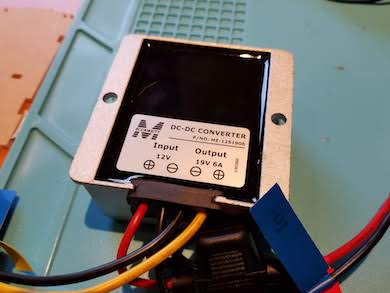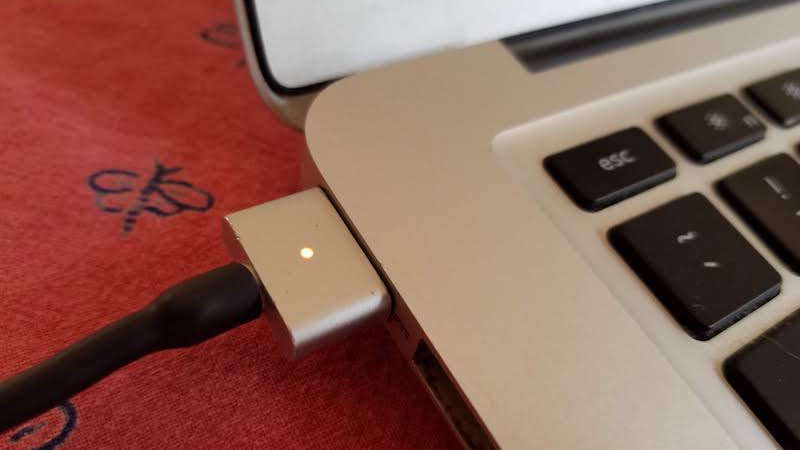[Steve Chamberlin] has a spiffy solar-charged 12 V battery that he was eager to use to power his laptop, but ran into a glitch. His MacBook Pro uses Apple’s MagSafe 2 connector for power, but plugging the AC adapter into the battery via a 110 VAC inverter seemed awfully inefficient. It would be much better to plug it into the battery directly, but that also was a problem. While Apple has a number of DC power adapters intended for automotive use, none exist for the MagSafe 2 connector [Steve]’s mid-2014 MacBook Pro uses. His solution was to roll his own MagSafe charger with 12 VDC input.
 Since MagSafe connectors are proprietary, his first duty was to salvage one from a broken wall charger. After cleaning up the wires and repairing any frayed bits, it was time to choose a DC-DC converter to go between the MagSafe connector and the battery. The battery is nominally 12 volts, so the input of the DC-DC converter was easy to choose, but the output was a bit uncertain. Figuring out what the MagSafe connector expects took a little educated guesswork.
Since MagSafe connectors are proprietary, his first duty was to salvage one from a broken wall charger. After cleaning up the wires and repairing any frayed bits, it was time to choose a DC-DC converter to go between the MagSafe connector and the battery. The battery is nominally 12 volts, so the input of the DC-DC converter was easy to choose, but the output was a bit uncertain. Figuring out what the MagSafe connector expects took a little educated guesswork.
The original AC adapter attached to the charger claimed an output of 20 volts, another Apple adapter claimed a 14.85 V output, and a third-party adapter said 16.5 volts. [Steve] figured that the MagSafe connectors seemed fine with anything in the 15 to 20 V range, so it would be acceptable to use a 12 V to 19 V DC-DC boost converter which he had available. The result worked just fine, and [Steve] took measurements to verify that it is in fact much more efficient than had he took the easy way out with the inverter.
MagSafe has been displaced by USB-C nowadays, but there are plenty of MagSafe devices still kicking around. In a pinch, keep in mind that a little bit of filing or grinding is all that’s needed to turn MagSafe 1 into MagSafe 2.















The voltage is dependent of the wattage of the MagSafe. There’s a One Wire communication in the tip of the wire which tells mac the available wattage.
14.5V @ 45W
16.5V @ 65W
18.5V @ 75W
I’ll have to revise my understand. I was under the impression the 1wire coms just controled the LED. The charge power was determined from the supplied voltage.
What you describe sounds more likely though.
Here is everything you need to know: http://www.righto.com/2013/06/teardown-and-exploration-of-magsafe.html
Awesome resource
…and of course, it’s the man, the myth, the reverse engineering legend Ken Shirriff to the rescue!
A couple of (about 10) years back, I had the same ‘problem’ in a camper. When off-the-grid, the laptop had a hard time of working any longer then 2 hours on its own battery. Yep, pretty power hungry laptops have a hard time of working any longer.
So, I found a car converter that did the job by boosting from 13.8 V (or 12 V) to 18/19 V (to be determined by a setting) and it even had different adapter tips.
Way more efficient then using the inverter/adapter combo and those cheap inverters usually are ‘dirty’, so not a real good idea for your laptop adapter.
Now, with these all pre-built boost converters, it is pretty safe and I wish you lots of fun with it.
A Laptop adapter normally is a wide input range switch mode converter. The first thing it does is rectifying the mains voltage. So it should not have any problem with “dirty” power, many accept even 300V DC, but I don’t know details about Apple.
Although I know, that an Apple PSU did not have a problem with a cheap “modified sine” ( I would call it “modified square wave”) inverter. Until the inverter died due to underrated input caps. But I found some suitable replacement in the parts bin. It now feeds chargers for power tools (battery operated drill, chain saw, angle grinder, circular saw,…) in the garden house without grid connection.
Agreed about calling is “modified square wave” – there’s nothing “sine” about what they put out.
Does anybody have any advice for charging a USB-C PD laptop off of a 12v battery? I’ve come across a couple products that do exactly that but I’m worried about running them at full power for long periods.
I’ve seen one-chip solutions that are for powering a project via PD, is there anything similar for supplying the power?
I guess the question is really how well your battery will cope with providing that sort of energy level. e.g. 100W @ 12V ~= 8A. So e.g. an 18Ah battery may provide capacity for just over 2 hours of run time, BUT, the 18Ah value is measured at 1A draw, not 8A. The higher current draw may damage the battery.
8A for an 18Ah (lead acid) battery will not damage it, but for sure it will reduce it’s available energy.
That’s a good point about power draw on the batteries. I’ve got a couple deep cycle lead acids though so the current draw shouldn’t be too much concern. Especially since regardless of how I would charge my laptop (DC-DC or DC-AC-DC) it would be a pretty big load.
Something like … https://www.amazon.co.uk/dp/B07NV6XT41/ perhaps?
Coolgear has lots of stuff: https://www.coolgear.com/product-category/odm/usb-charger-boards
Oh wow, they do have some cool stuff. Thanks.
I used a USB-C terminator chip (also featured here on HaD) to give me 15v….then put a magsafe plug on that. Now I can charge both my MacBooks from USB-C (one is native and the other Magsafe 2)
Share your solution! Would love to see this, I have to power several old and new mac laptops and it would be wonderful to not carry so many adaptors.
https://www.amazon.com/usb-c-magsafe-2/s?k=usb-c+to+magsafe+2